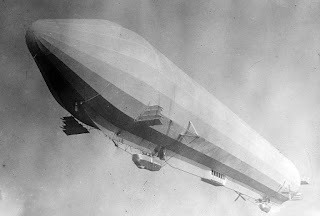Today is an auspicious day in aviation history. One hundred and six years ago, the world’s first commercial air flight took place by the world’s first commercial aircraft. The LZ-7 Deutschland took off from Dusseldorf, Germany with 24 passengers on board. She was owned by the world’s first airline company — the DELAG (German Airship Transportation Corporation).
The LZ-7 Deutschland
The Deutschland was, at the time, the largest aircraft that had ever been built. She was 486 feet long and 46 feet in diameter. Her gas cells were inflated with 683,000 cubic feet of hydrogen and she had a useful lift of 11,000 pounds. The airship had a crew of 8 or 9 men and had room for two dozen passengers in addition to some cargo capacity.
The passenger cabin was enclosed and had windows for viewing, was paneled in mahogany, and inlaid with mother-of-pearl.
The Passenger Cabin of the Deutschland
The zeppelin was powered by three 125 horsepower Daimler engines. Her top speed was just over 37 miles per hour and her cruising speed was 33 miles per hour.
By contrast, the world’s first mass produced airplane, the Wright Model B, could carry, aside from the pilot, one passenger or a small cargo — and nothing was enclosed. The plane was completely open. The Model B flew at an average speed of 44 miles per hour.
The Wright Model B Biplane
“A Three Hour Tour”
On that beautiful Tuesday morning, 106 years ago, the LZ-7 Deutschland rose into the sky. Twenty-three journalists were on board, along with DELAG director Alfred Colsman. The passengers enjoyed a light breakfast of champagne and caviar shortly after take off. What a delightful way to start off a three hour sightseeing tour.
Note: Breakfast was not served on the Wright Model B.
Interior View of the Deutschland's Passenger Cabin
“The Weather Started Getting Rough”
Captain Kahlenberg, formerly of the Prussian Airship Battalion, was relatively inexperienced and committed several judgement errors. Most airship crashes were due to such errors of judgment. For his, Kahlenberg was sacked and the Zeppelin company began emphasizing safety first.
Kahlenberg’s first mistake was his failure to get a weather report before take off. His second was to fly before the wind towards more picturesque scenery. When he suddenly found the wind had dramatically increased, he also discovered he couldn’t fly his underpowered airship into the wind and return to base. And it was a situation made worse by the failure of one of the engines. Kahlenberg found himself, his passengers, and crew pushed along by the wind and he was unable to do anything about it.
Having no radio on board, Captain Kahlenberg frantically dropped notes to the ground asking local Army garrisons for assistance in landing the giant ship. And all the while, the wind pushed the Deutschland towards the towering thunderheads over Teutoberger Forest.
“The Giant Ship Was Tossed”
By late afternoon, the airship was being driven rapidly along towards its rendezvous with destiny. The crew was helpless to stop the relentless drive towards the oncoming thunderstorm. And when the zeppelin at last collided with the storm front, the updrafts caused her to shoot up to 3,600 feet. During her rapid and wild ascent, hydrogen was automatically valved from the swollen gas cells. Finally, heavy with rain and with insufficient lift gas, the airship plunged to earth and crashed into the forest pines.
Unlike the Minnow of Gilligan’s Island, in spite of the crew’s best efforts, the Deutschland was lost. The nine hour ordeal was over. However, unlike a modern airliner crash, there were no fatalities and the only injury occurred to a crewman who jumped from the airship and broke his leg.
Safety First
Certainly not the way an airline company would choose to start out operations. Count Zeppelin, though, made changes, lots of changes, changes that resulted in German airships having the best safety record the world has ever seen.
The DELAG, in its four years of operations before World War I, carried over 34,000 passengers on over 1500 flights without a single injury.
After the war, the safety record continued with flights by the Bodensee, Graf Zeppelin, and Hindenburg. And as spectacular a disaster as was the tragic burning of the Hindenburg in 1937, the loss of life was relatively small. Twenty-six percent of the passengers and crew died. Compare that with 100% loss of life from the increasing numbers of jet airliner crashes today.
Perspective
Passenger air travel became a reality 106 years ago today. And while the first flight ended in the destruction of the airship, no lives were lost.
The Graf Zeppelin flew over a million miles without a single casualty and many of those miles were as a passenger aircraft.
The next time you board a jetliner and squeeze yourself into your seat and have a complimentary drink, think of the flight of the Deutschland. They had room to walk around and enjoyed a breakfast of champagne and caviar.
The LZ-7 Deutschland






No comments:
Post a Comment